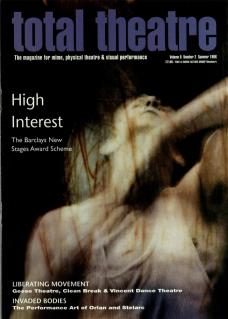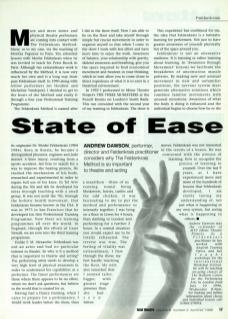More and more mime and physical theatre performers are coming into contact with The Feldenkrais Method. Many, as in my case, via the teaching of Monika Pagneux in Paris. She attended lessons with Moshe Feldenkrais when he was invited to teach for Peter Brook in Paris. Although her extraordinary work is influenced by the Method, it is now very much her own and is a long way from pure Feldenkrais itself. In 1990 along with fellow performers Jos Houben and Micheline Vandepoel, I decided to get to the heart of the Method and study it through a four-year Professional Training Programme.
The Feldenkrais Method is named after its originator Dr. Moshe Feldenkrais (1904-1984). Born in Russia, he became a distinguished physicist, engineer and Judo master. A knee injury, resulting from a sports accident, led him to search for a way to improve the healing process. He studied the mechanism of his body, researched and experimented in order to regain full use of his knee. In Tel Aviv during the 50s and 60s he developed his ideas through teaching with a small group. It was not until the 70s, through the holistic health movement, that Feldenkrais became known in the USA. It was in 1975 in San Francisco that he developed his first Professional Training Programme. Now there are training programmes all over the world. In England, through the efforts of Garet Newall, we are now into the third training programme.
Unlike E M. Alexander, Feldenkrais was not an actor and had no particular interest in theatre. So why is it a method that is important to theatre and acting? The performing artist needs to develop a very high level of physical awareness in order to understand his capabilities as a performer. The finest performances are those where there appears to be no effort, where we don't ask questions, but believe in the world that is created for us.
Having had a dance training, when I came to prepare for a performance, I would work harder before the show, than I did in the show itself. Now I am able to lie on the floor and take myself through simple but crucial movements in order to organise myself so that when I come to the show I work with less effort and have more time to enjoy the work. Awareness of balance, your relationship with gravity, skeletal awareness and breathing, give you the space required to find economical movement and freedom in your thinking, which in turn allow you to come closer to direct experience of what it is to exist in a theatrical environment.
In 1992 I performed in Mime Theatre Project's The Three Musketeers at the Purcell Rooms on London's South Bank. This run coincided with the second year of my training in Feldenkrais. The show is a marathon – three of us running round being Musketeers, horses, castles and the odd chicken. It was fascinating to me to put the method and performance so intensely together. I was lying on a floor in Lewes for four hours, then dashing to London and performing for a further two hours. In a normal situation you would expect me to be totally exhausted. The reverse was true. The feeling of vitality was extraordinary, I flew through the show, my feet hardly touching the floor. My wife also remarked that I seemed taller, bigger, with greater stage presence than she had seen before.
This experience has confirmed for me the idea that Feldenkrais is a fantastic learning for performers. Not just to have greater awareness of yourself physically but of the space around you.
Feldenkrais is not an alternative medicine. It is learning or rather learning about learning. In 'Awareness through Movement’ lessons we facilitate the breakdown of unconscious muscle patterns. By making new and unusual movement in new and unfamiliar positions, the nervous system must generate alternative solutions which combine familiar movements with unusual sensations. Awareness of what the body is doing is enhanced and the individual begins to choose how he or she moves. Feldenkrais was not interested in the results of a lesson. He was concerned with the process of learning, how to recognise the process of learning in yourself. Over the last nine years, as I have experienced more and more of the hundreds of lessons that Feldenkrais developed, I am slowly tuning my understanding of, not just what is happening in my own system, but seeing what is happening in others.

